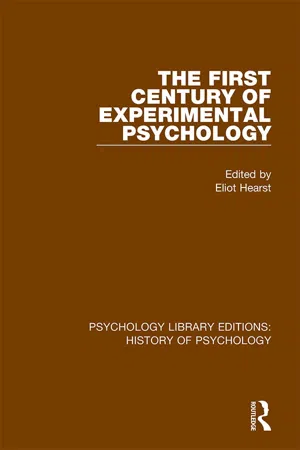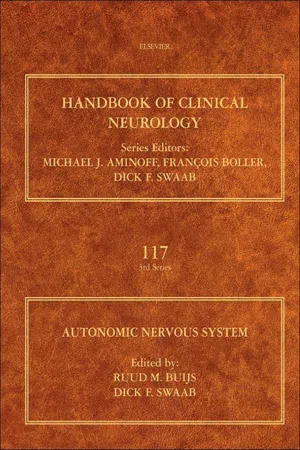Cannon Bard Theory
The Cannon-Bard theory of emotion proposes that emotions and physiological responses occur simultaneously, rather than one causing the other. According to this theory, an emotional stimulus triggers both the experience of an emotion and the physiological response independently. This challenges the earlier James-Lange theory, which suggested that physiological responses lead to the experience of emotion.
4 Key excerpts on "Cannon Bard Theory"
- Chris R. Brewin(Author)
- 2013(Publication Date)
- Psychology Press(Publisher)
...Because the literature on cognition and affect is extensive, we will focus on four topic areas of direct relevance to clinical practice. The first is concerned with cognitive theories of emotion, i.e., theories that emphasize the importance of a person’s cognitions in determining the nature of the emotional response. An opposing perspective, namely that affective judgments often occur prior to cognitive operations, forms the second topic. The third concerns the influence of transient emotional states on cognitive processes, particularly memory. The fourth deals with emotional reactions to major stressors from the point of view of imagery and memory processes, and includes an account of how emotional memories may be altered by exposure to corrective information. By this point we shall be in a better position to discuss the complex nature of the relationship between cognition and affect. Cognitive Theories of Emotion Cognitive processes such as attention, recognition, and forgetting should in theory be able to occur with little, if any, accompanying affect, so long as the material being processed has no particular emotional significance for the individual. To ask a person to identify the capital cities of the countries of South America may be assumed to be a fairly affect-free task, unless that person has pleasant or unpleasant memories from a previous visit. Cognitive theories of emotion assume that a stimulus or a situation must first be attended to, recognized or classified, and related to previous experiences stored in memory before it can be evaluated or can arouse an emotional response. A small number of “basic” emotional responses have been identified, and it has been suggested that other emotions are made up of a blend of these...
- eBook - ePub
- Elliot Hearst, Eliot Hearst(Authors)
- 2019(Publication Date)
- Routledge(Publisher)
...It is obvious that neither of those two sequences is satisfactory today. Candland et al. (1977) suggest instead the “continuous loop model,” which recognizes that certain stimuli elicit both “cognitive and physiological components of the emotional experience concurrently. Neither cognitive nor physiological factors are antecedents…. [They] are viewed as feeding back upon and modifying both continuing emotional experiences and future emotional responses [p. 66].” Therefore, what a psychology of emotion must address are the conditions that give rise to cognitive and physiological events and the combination rules for these two. However, it is likely that simple combination rules will not satisfy the search for the psychological explication of emotional experience. At least at the introspective and anecdotal level, emotional experiences do not have the appearance of additions of two kinds of events: physiological and cognitive. Rather, the whole is different from the sum of its parts. Maybe the next step will be a neogestaltist theory of emotion, just as modern structuralism has taken over the field of cognition, memory, social behavior, and development. With the advent of the new mentalism in the second half of the twentieth century, future psychologists may indeed combine rigorous experimental methods and innovative theory to address the problem of the structure of emotional experience. ACKNOWLEDGMENTS Preparation of this chapter was supported by grant No. MH-15828 from the National Institute of Mental Health to the Center for Human Information Processing. I am greatly indebted to Roy D’Andrade, Jean Mandler, and Dianne Sargent-Pollock, whose comments greatly improved an early draft. The volume editor, Eliot Hearst, contributed beyond the call of duty to protect me from the infelicities, inaccuracies, and uncertainties of my first draft. In addition, the comments of eight reviewers, both known and anonymous, friendly and critical, also contributed to the final product...
- eBook - ePub
- Antonella Sansone(Author)
- 2020(Publication Date)
- Routledge(Publisher)
...Chapter Two A psychophysiological theory of emotions Our body is involved in our relationships as much as our mind. The two levels of our being are inseparable and a circular relation exists between them. They are split only by language and concepts. While thinking, speaking, dreaming, and interacting there are changes in our breathing, muscle tone, posture, and facial expression, —throughout our body language. They are powerful forms of non-verbal communication. Psychological phenomena emerge from the complex interaction between systems in the body and the brain. The body image exists in the neocortex, which is the outer layer of the brain. It is a process involving the deep brain, the skeletal frame, the muscular system, and all bodily activities. The neocortex is a highly sophisticated entity that collects, assembles, associates, analyses, and stores data provided by sensory organs. The subcortical nervous system or primitive brain is closely connected with the hormonal and immune systems, our emotions and instincts. 1 There is continuous interaction between the neocortex and the primitive brain. Information travels along the spinal cord and reaches the hypothalamus, which controls the autonomic nervous system (Luria, 1973). The hypothalamus is closely connected with the limbic system and together they form the locus of emotional centres. They form a complex network that can be conceived as a “primal adaptive system”. The right hemisphere in particular contains an integrated map of the bodily state and plays a primary role in the regulation of fundamental physiological and hormonal functions...
- eBook - ePub
- Ruud M. Buijs, Dick F. Swaab, Ruud M. Buijs, Dick F. Swaab(Authors)
- 2013(Publication Date)
- Elsevier(Publisher)
...Subsequent attempts have been made to reconcile these distinct views by incorporating the role of cognitive appraisal. The two-stage model of Schachter and Singer argued changes in peripheral arousal can elicit subjective emotionality “of corresponding intensities,” yet, the nature of the emotion category is determined by cognitive context (Schachter and Singer, 1962). Thus, emotional states are states of arousal, whose type (e.g., fear, happiness, sadness) is determined by the cognitive interpretation of what evoked that state. The somatic marker hypothesis, discussed above (Autonomic interaction with decision making), conceptualizes emotions and emotional feeling states along similar lines, with perhaps a more negative bias. Studies in clinical populations with altered peripheral physiological responses and altered affect provide insight into the relationship between autonomic patterning and subjective emotional feeling states. It is recognized that emotion behaviors (e.g., pathological laughter) can deviate from peripheral physiological state but such instances are the exception (Parvizi et al., 2001). The absence of peripheral autonomic response, for example, in patients with pure autonomic failure (PAF), an acquired failure of peripheral autonomic regulation, may lead to subtle blunting of emotional feeling (appearing less anxious relative to comparably debilitated Parkinson’s patients without autonomic failure (Mathias, 2003 ; Critchley, unpublished observations)), but these effects are subtle relative to other emotional changes (see below). The uncoupling of brain and body that occurs in part following high spinal cord transection has been suggested to lead to altered emotions...



